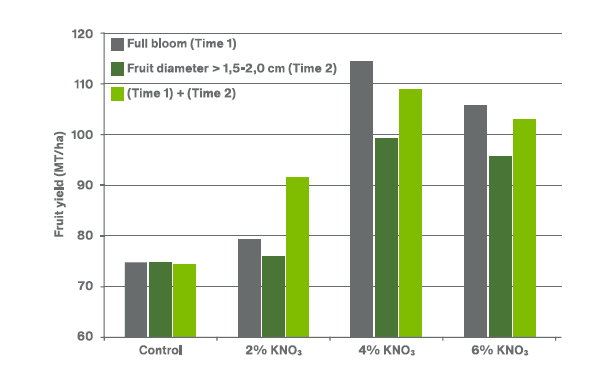Foliar potassium nitrate applications in citrus are beneficial in terms of fruit yield, number of fruits and reducing fruit splitting
Citrus trees are heavy consumers of nitrogen (N) and potassium (K). Potassium nitrate (KNO₃) is the preferred source of nitrogen and potassium in citrus nutrition, leading to healthier trees, better fruit quality and increased disease resistance.
The synergy between the potassium cation (K+) and the nitrate anion (NO3-) in potassium nitrate helps maintain the electrochemical balance within the roots and the plant, optimizing the uptake of nitrogen and potassium, as well as other essential cations like calcium (Ca2+) and magnesium (Mg2+). This balance is crucial for maximizing nutrient efficiency and minimizing the uptake of excess chlorides.
For fertigation programs, potassium nitrate ensures that the largest quantities of nitrogen and potassium required by citrus trees are delivered effectively. It also helps maintain an optimal pH around the roots, which is essential for the health of the plant.
Foliar applications of potassium nitrate are particularly beneficial during periods of high nutrient demand, such as flowering and fruit set, especially when soil temperatures are low.
Three application rates of 2%, 4%, and 6% potassium nitrate was applied as foliar sprays on “Washington Navel” (Citrus sinensis).

The first application occurred during the full bloom stage and the second application took place when the fruit diameter was between 1.5 to 2.0 cm.
These applications have been shown to improve fruit set, increase fruit size and weight, enhance yield and reduce the occurrence of split fruit.
Trees sprayed during the first application or both the first and second applications showed the best results in terms of reducing fruit splitting. Reduction in fruit splitting was observed only for potassium nitrate sprays at 4% and 6%.
The highest yield increase of 53% compared to the control was achieved with a single spray during full bloom using 4% potassium nitrate. This increase in yield was attributed to the higher number of fruits per tree harvested.
In summary, foliar potassium nitrate (UltrasolKPlus1andUltrasolKPlus Acid2) applications play a crucial role in enhancing citrus fruit production, improving fruit quality and minimizing fruit splitting.
SQM
References:
Abd El-Rahman, G.F., M.M. Hoda, and A.H.T. Ensherah. (2012). “Effect of GA3 and potassium nitrate in different dates on fruit set, yield and splitting of Washington navel orange.” Nature and Science, 10(1), 148-157.
Disclaimer
The information herein contained is given to the best of SQM’s knowledge and is believed to be accurate. The conditions of your use and application of the suggested recommendations, are beyond our control. No warranty is made as to the accuracy of any data or statements contained herein. SQM specifically disclaims any responsibility or liability relating to the use of the recommendations and shall under no circumstances whatsoever, be liable for any special, incidental or consequential damages arising from such use.



